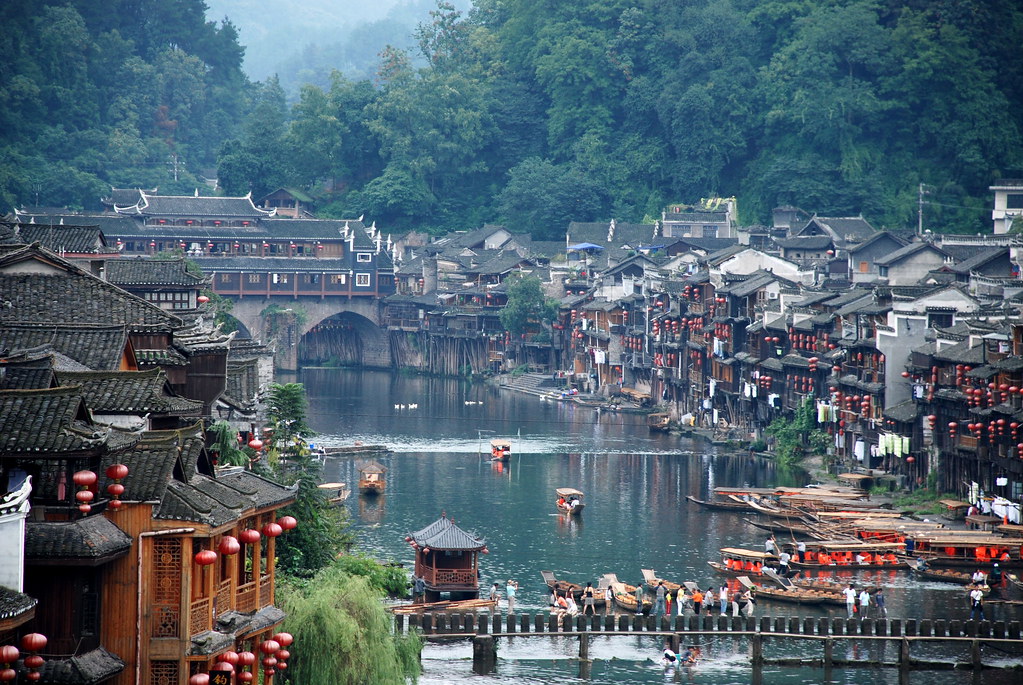A few days ago, we told the story and the importance in the Chinese tradition of the Feng Huang, the Oriental Phoenix, the mythical firebird considered sacred, a symbol of longevity and good omen.
But the same name, as some of our readers have rightly pointed out, is also the name of a beautiful village, suspended in time. A city considered amongst the most beautiful in China. Today we would like to tell the story of Fenghuang (凤凰 古城), famous for its natural beauty, its history, and timeless charm, so much to earn the title of the "Oriental Venice".

The ancient city of Fenghuang is called as the famous Phoenix of the East precisely because its history is intertwined with the legend of these mythological creatures. In fact, it is said that:
"After flying over the Country for many kilometers, a couple of young Phoenicians accidentally reached a small town that stood on the edge of a river. The beauty of the small village, nestled like a diamond in the green of the lush nature, marvelled to such an extent two Phoenicians that they decided to settle there".
Fenghuang is located in the Hunan region, an area where the natural panoramas are amongst the most beautiful and breathtaking in all China. All travelers who reach this place are fascinated by the timeless beauty of this ancient, elegant, and mysterious village, surrounded by the greenery of lush nature.
Fenghuang is divided into two districts: the old city and the new city.
The origins of the old city are very ancient and date back to the Spring and Autumn Period (from 770 to 476 BC), while the most recent part dates back to the reign of the Qing Dynasty Emperor Kangxi (1704), with typical buildings of the period, very well preserved.
The city is a perfect combination between the beauty of the natural mountain landscape and the charm of the traditional history and culture of the ethnic groups that live there, mainly the Miao and Tujia ethnic minorities. Both still maintain their traditional customs and speak their local language.
The best way to visit Fenghuang is walking, because the city is a real open-air museum. Going around the narrow streets and the dozens of ancient and winding alleys lined with traditional houses and historical residences, in typical Ming and Qing style, literally makes you travel through time and allows you to discover what life was like in China before modernity.
The city boasts over 300 historical sites. These include the Huang Si Qiao Castle (黄丝桥古城), a beautifully preserved stone fortress built in 687 during the Tang dynasty, and the Xiangxi perimeter wall, built during the Ming dynasty (1368 - 1644), considered by many to be the "Great Wall" of southern China. And then there are the Longevity Palace (万寿宫), the Chaoyang Palace (朝阳 宫), the Hong Bridge (虹桥), the Oriental Tower (东门 城楼) and the Wanming Pagoda (万名 塔).
Honestly, an embarrassment of riches, really!
Another way to appreciate at best the particular architecture of Fenghuang is to take a boat ride along the banks of the Tuo Jiang River. From the river view, you can admire the Diaojiaolou (吊脚楼), the typical wooden houses built on stilts, characteristic of the Miao ethnicity.
Moreover, along the banks of the river, it is easy to see women washing clothes and men fishing, while food it's still prepared on the quay almost the same way it has been for centuries.
Also, the night view of Fenghuang is enchanting: all the ancient buildings overlooking the river are illuminated, and at sunset the numerous premises fill up, and the streets are teeming with people.
Last but not least, often on the Tuo Jiang River are held wonderful celebrations, useful to get to know the traditions and culture of the Miao ethnic population. On the contrary, during the first hours of the day, the city seems completely different, a silent and peaceful place.
The old city of Fenghuang is curiously famous also for its ginger candies, an original mix of sweet and spicy, still prepared today according to a very ancient recipe.
It is also renowned for its very spicy cuisine. Some typical dishes are the black pudding with duck meat and glutinous rice (血 粑 ), the soup of the Miao ethnic group (苗家 酸汤) and the smoked pork (腊肉).
The climate of Fenghuang is characterized by a sub-tropical and monsoon humid weather, with four distinct seasons, plentiful rainfall and abundant sunshine.
The best seasons to visit the city are spring and autumn. The period from September to November is also recommended because the temperature is ideal, and the summer rains are over. The days are hot and the nights are fresh.
The rainy season lasts from April to June. After the rain, the hazy landscape looks like a traditional Chinese painting. In December and January, the air is cold and it snows very often. Still, being low season, there are fewer tourists.
Therefore, when it will be possible again to travel to China, do not forget to include the wonderful Fenghuang, the Oriental Venice, in your itinerary!








Follow us